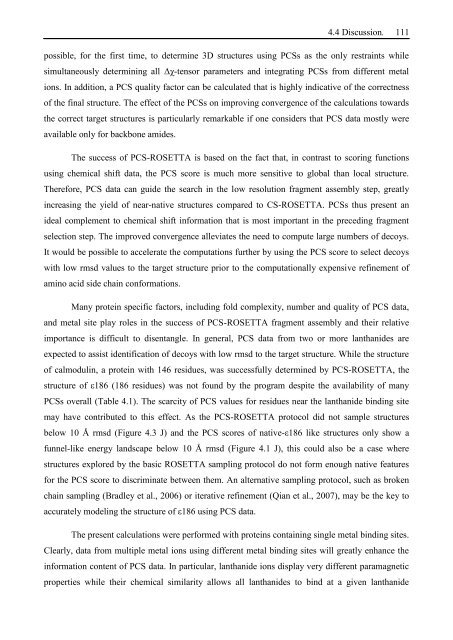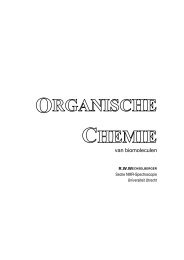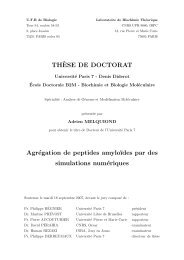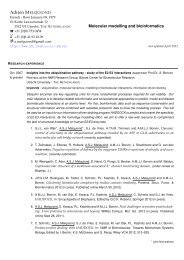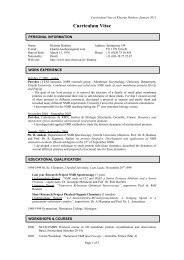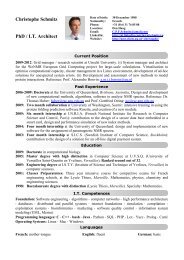Thesis Title: Subtitle - NMR Spectroscopy Research Group
Thesis Title: Subtitle - NMR Spectroscopy Research Group
Thesis Title: Subtitle - NMR Spectroscopy Research Group
Create successful ePaper yourself
Turn your PDF publications into a flip-book with our unique Google optimized e-Paper software.
4.4 Discussion. 111<br />
possible, for the first time, to determine 3D structures using PCSs as the only restraints while<br />
simultaneously determining all Δχ-tensor parameters and integrating PCSs from different metal<br />
ions. In addition, a PCS quality factor can be calculated that is highly indicative of the correctness<br />
of the final structure. The effect of the PCSs on improving convergence of the calculations towards<br />
the correct target structures is particularly remarkable if one considers that PCS data mostly were<br />
available only for backbone amides.<br />
The success of PCS-ROSETTA is based on the fact that, in contrast to scoring functions<br />
using chemical shift data, the PCS score is much more sensitive to global than local structure.<br />
Therefore, PCS data can guide the search in the low resolution fragment assembly step, greatly<br />
increasing the yield of near-native structures compared to CS-ROSETTA. PCSs thus present an<br />
ideal complement to chemical shift information that is most important in the preceding fragment<br />
selection step. The improved convergence alleviates the need to compute large numbers of decoys.<br />
It would be possible to accelerate the computations further by using the PCS score to select decoys<br />
with low rmsd values to the target structure prior to the computationally expensive refinement of<br />
amino acid side chain conformations.<br />
Many protein specific factors, including fold complexity, number and quality of PCS data,<br />
and metal site play roles in the success of PCS-ROSETTA fragment assembly and their relative<br />
importance is difficult to disentangle. In general, PCS data from two or more lanthanides are<br />
expected to assist identification of decoys with low rmsd to the target structure. While the structure<br />
of calmodulin, a protein with 146 residues, was successfully determined by PCS-ROSETTA, the<br />
structure of ε186 (186 residues) was not found by the program despite the availability of many<br />
PCSs overall (Table 4.1). The scarcity of PCS values for residues near the lanthanide binding site<br />
may have contributed to this effect. As the PCS-ROSETTA protocol did not sample structures<br />
below 10 Å rmsd (Figure 4.3 J) and the PCS scores of native-ε186 like structures only show a<br />
funnel-like energy landscape below 10 Å rmsd (Figure 4.1 J), this could also be a case where<br />
structures explored by the basic ROSETTA sampling protocol do not form enough native features<br />
for the PCS score to discriminate between them. An alternative sampling protocol, such as broken<br />
chain sampling (Bradley et al., 2006) or iterative refinement (Qian et al., 2007), may be the key to<br />
accurately modeling the structure of ε186 using PCS data.<br />
The present calculations were performed with proteins containing single metal binding sites.<br />
Clearly, data from multiple metal ions using different metal binding sites will greatly enhance the<br />
information content of PCS data. In particular, lanthanide ions display very different paramagnetic<br />
properties while their chemical similarity allows all lanthanides to bind at a given lanthanide


